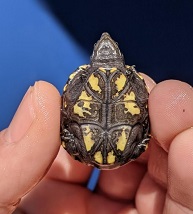Mississippi Mud Turtle (Kinosternon subrubrum hippocrepis)
Description: The Eastern mud turtle, with its subspecies Southestern mud turtle and Mississippi mud turtle, and the species Florida mud turtle, share many common similarities. The Mississippi mud turtle, in particular, is small and dark. There are yellow stripes running down the sides of their neck and head. Some others have pale tan stripes instead of yellow ones. The upper shell has dark brown or black shade, and there are no marks. The lower shell (plastron) is usually yellow with some browns. This mud turtle has a larger plastron compared to other turtles. It has an anterior and posterior hinge. But unlike boxed turtles, the plastron is not closable. Many of these turtles have algae growth on their shells, so they can be greenish in appearance. Their hind feet are webbed, while the front feet are not. Males have a tail tip that looks like a claw.
Habitat: Mississippi mud turtles prefer moist habitats. You can see them in shallow, stagnant, or slow moving waters that have aquatic vegetation. They avoid flowing rivers. Spot these turtles in swamps, ditches, ponds, lakes, and bayous
Range: In North America, you can see them between Central Texas and New York, up to the tip of Florida Peninsula.
Diet: Mississippi mud turtles are omnivores. Their diet is a mix of both animal and plant food. They forage the bottom of swamps, ponds, (or whatever habitat they are in) for aquatic insects and vegetation.
Reproduction: These mud turtles mate all through April to July. Females are mature at 6 years. They lay up to 6 eggs in clutches of 3 or sometimes more. Males sexually mature once they reach 3 inches in carapace length. Mississippi mud turtles nest mostly anywhere. You may see them nesting in other animal burrows or dry, sandy soil. Eggs incubate for 3 to 3.5 months, then hatch. Hatchlings are less than 1 inch in carapace length.
Status: Eastern mud turtles are classified as a species of "Least Concern" according to IUCN Red List. They are not listed on the US Federal List, CITES, and the state of Michigan List. Eastern mud turtles are considered state-endangered in Indiana, New York, and Pennsylvania, and a species of greatest conservation need in Kentucky
The main threat to these turtles is habitat loss and highway mortality, as few turtles manage to cross highways. Habitat loss via roads bisecting aquatic habitats, increased urbanization, and a change in climate that elevates sea levels all harm these mud turtles. Illegal pet trade of this species also has caused damage to their native ecosystem via loss of biodiversity.
»» Kingdom: Animalia - Animals
»» Phylum: Chordata - Chordates
»» Subphylum: Vertebrata - Vertebrates
»» Class: Reptilia - Reptiles
»» Order: Testudines - Turtles & Tortoises
»» Family: Kinosternidae - Mud & Musk Turtles
»» Genus: Kinosternone
»» Species: Kinosternon subrubrum - Eastern Mud Turtles
»» Subspecies: Mississippi Mud Turtle - ( Kinosternon subrubrum hippocrepis)
This article uses material from the Wikipedia article "ANIMAL", which is released under the Creative Commons Attribution-Share-Alike License 3.0. Content may have been omitted from the original, but no content has been changed or extended.
|













